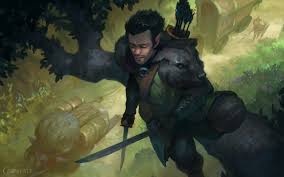Half-Elf
Flint squinted into the setting sun. He thought he saw the figure of a man striding up the path. Standing, Flint drew back into the shadow of a tall pine to see better. The man’s walk was marked by an easy grace—an elvish grace, Flint would have said; yet the man’s body had the thickness and tight muscles of a human, while the facial hair was definitely humankind’s. All the dwarf could see of the man’s face beneath a green hood was tan skin and a brownish-red beard. A longbow was slung over one shoulder and a sword hung at his left side. He was dressed in soft leather, carefully tooled in the intricate designs the elves loved. But no elf in the world of Krynn could grow a beard
. . . no elf, but . . .
“Tanis?” said Flint hesitantly as the man neared.
“The same.” The newcomer’s bearded face split in a wide grin. He held open his arms and, before the dwarf could stop him, engulfed Flint in a hug that lifted him off the ground. The dwarf clasped his old friend close for a brief instant, then, remembering his dignity, squirmed and freed himself from the half-elf’s embrace.
Basic Information
Anatomy
To humans, half-elves look like elves, and to elves, they look human. In height, they’re on par with both parents, though they’re neither as slender as elves nor as broad as humans. They range from under 5 feet to about 6 feet tall, and from 100 to 180 pounds, with men only slightly taller and heavier than women. Half-elf men do have facial hair, and sometimes grow beards to mask their elven ancestry. Half-elven coloration and features lie somewhere between their human and elf parents, and thus show a variety even more pronounced than that found among either race. They tend to have the eyes of their elven parents.
Civilization and Culture
Naming Traditions
Half-elves use either human or elven naming conventions. As if to emphasize that they don’t really fit in to either society, half-elves raised among humans are often given elven names, and those raised among elves often take human names.
Culture and Cultural Heritage
Half-elves have no lands of their own, though they are welcome in human cities and somewhat less welcome in elven forests. In large cities in regions where elves and humans interact often, half-elves are sometimes numerous enough to form small communities of their own. They enjoy the company of other half-elves, the only people who truly understand what it is to live between these two worlds.
In most parts of the world, though, half-elves are uncommon enough that one might live for years without meeting another. Some half-elves prefer to avoid company altogether, wandering the wilds as trappers, foresters, hunters, or adventurers and visiting civilization only rarely. Like elves, they are driven by the wanderlust that comes of their longevity. Others, in contrast, throw themselves into the thick of society, putting their charisma and social skills to great use in diplomatic roles or as swindlers.
In most parts of the world, though, half-elves are uncommon enough that one might live for years without meeting another. Some half-elves prefer to avoid company altogether, wandering the wilds as trappers, foresters, hunters, or adventurers and visiting civilization only rarely. Like elves, they are driven by the wanderlust that comes of their longevity. Others, in contrast, throw themselves into the thick of society, putting their charisma and social skills to great use in diplomatic roles or as swindlers.



Comments